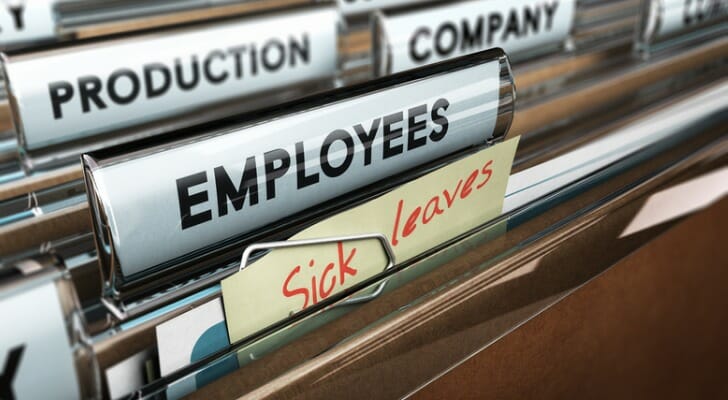As the COVID-19 outbreak continues, a growing number of Americans are unable to work and are thus exploring avenues of coronavirus relief. Some are sick, waiting to find out if they are sick or under quarantine orders, while others have to stay home to care for family members who are sick, quarantined or home from school. Before recent legislation, paid sick leave was mostly available only to employees who work for large corporations. But since the Families First Coronavirus Response Act (FFCRA) passed, and subsequent Coronavirus Aid, Relief and Economic Security (CARES) Act, employees who work for companies with 500 or fewer workers are also entitled to paid sick leave. It’s a major advance for the mandatory paid sick leave movement that has largely gone unnoticed.
That may partly be because FFCRA has a sunset provision: small companies are required to pay for sick leave only until the end of the year. The law also spells out permitted reasons for paid sick leave, generally COVID-19. The subsequent CARES Act clarifies how much companies are required to pay. Read on for more about federally mandated paid sick leave. Even if you’re not sick now, it’s as important to stay up to date about these provisions as it is to be informed about the coming coronavirus stimulus checks or to be prepared for the looming economic recession. Indeed, if these uncertain times are keeping you up at night, you may want to speak to a financial advisor in your area.
Paid Sick Leave & the Families First Coronavirus Response Act (FFCRA)
The FFCRA mandates that employers provide paid sick or family leave benefits to employees affected by COVID-19. The act, enforced by the U.S. Department of Labor (DOL), expands upon the existing Family and Medical Leave Act (FMLA). The FFCRA includes three key provisions, which are set to expire at the end of 2020.
The first is that eligible employees receive up to two weeks (80 hours) of paid sick leave at their regular pay rate (capped by the CARES Act at $511 daily and $5,110 total) in circumstances where they cannot work or telework for one of three reasons:
- They are subject to a federal, state or local quarantine related to COVID-19.
- A health provider has advised them to self-quarantine because of COVID-19.
- They are experiencing COVID-19 symptoms and are seeking a medical diagnosis.
Secondly, the bill mandates that employees receive up to two weeks of paid sick time at two-thirds of their regular pay rate (capped by the CARES Act at $200 daily and $2,000 total) in circumstances where they cannot work or telework for one of these three reasons:
- They have to care for an individual subject to quarantine or self-quarantine.
- They have to care for a child (under 18 years of age) whose childcare provider is unavailable or school is closed, both due to coronavirus-related reasons.
- They are experiencing any other similar condition specified by the Secretary of Health and Human Services, in consultation with the Secretaries of Labor and Treasury.
Finally, the bill’s third provision mandates up to an additional 10 weeks of expanded family and medical leave at two-thirds the rate of the employee’s pay rate (capped at $200 daily and $10,000 total) if the employee cannot work because they need to care for a child whose school is closed or childcare provider can’t work for reasons related to COVID-19. The employee must have been working for 30 calendar days to be eligible.
The provisions are effective as of April 1, 2020, and will remain active through Dec. 31, 2020. Also, they apply to part-time workers, who are eligible for leave for the number of hours they normally would have been scheduled to work.
One thing to note is that the FFCRA is actually two provisions in one. It consists of the Emergency Paid Sick Leave Act (ESPLA) and the Emergency Family and Medical Leave Expansion Act (EFMLA).
Who Is Eligible for COVID-19 Paid Sick Leave?

The DOL deems all employees under “covered employers” eligible to receive the FFCRA’s paid leave benefits. But exactly which employers are covered? The bill’s guidelines apply to certain public employers, as well as private employers with 500 or fewer employees.
That said, companies with fewer than 50 employees may be exempted from paying sick leave to parents who must stay home to care for their children if the requirement would jeopardize the business. Also, many federal government employees aren’t covered by FMLA provisions, but they’re covered by Title II of the Family and Medical Leave Act. But the paid sick leave provision still applies to federal employees, according to the DOL.
Relationship Between FFCRA and FMLA
As mentioned earlier, the FFCRA contains two acts. One of them is the Emergency Family and Medical Leave Expansion Act. This expands upon the existing FMLA in several key ways.
During the time the FFCRA is active – from April 1, 2020 to Dec. 31, 2020 – the FMLA is expanded to include benefits for more people. Specifically, to be eligible for the additional 10 weeks of family and medical leave, you only have to have worked for the employer for 30 calendar days. Ordinarily, FMLA requires the employee to have worked for at least 12 months and to have clocked at least 1,250 hours of service for the employer during the 12-month period immediately preceding the leave.
Under these laws, an employee is entitled to up to 12 weeks of leave (the first two weeks unpaid or covered by ESPLA) for the purposes described in the EFMLEA: namely, taking care of a child whose school or place of care is closed or whose childcare provider is unavailable due to a public health emergency, in this case the COVID-19 crisis. Under this new law, though, and unlike the FMLA, the following ten weeks must be paid at two-thirds the employees’ regular rate of pay, up to $200 per day.
After this act expires at the end of 2020, the existing FMLA will not be impacted.
Paid Sick Leave Programs by State, County & City
Though the FFCRA provides paid sick leave benefits at the federal level, Washington, D.C. and a number of states, counties and cities currently offer their own paid sick leave laws. Here’s a breakdown:
Paid Sick Leave Programs by State, County & City
| State | Cities/Counties |
| Arizona | None |
| California | Berkeley, Emeryville, Long Beach, Los Angeles, Oakland, San Diego, San Francisco, Santa Monica |
| Colorado | None |
| Connecticut | None |
| Washington, D.C. | None |
| Illinois (no state program) | Chicago, Cook County |
| Maine | None |
| Maryland | Montgomery County |
| Massachusetts | None |
| Michigan | None |
| Minnesota (no state program) | Duluth, Minneapolis, St. Paul |
| Nevada | None |
| New Jersey | None |
| New York | New York City, Westchester County |
| Oregon | None |
| Pennsylvania (no state program) | Philadelphia, Pittsburgh |
| Rhode Island | None |
| Texas | Austin, Dallas, San Antonio |
| Vermont | None |
| Washington | SeaTac Airport, Seattle, Tacoma |
Although it did not have one before the COVID-19 outbreak, New York State now has a paid sick leave program in place. In addition, the law includes a range of coronavirus unemployment benefits, family leave, and disability benefits for workers across the state. However, on a local level, New York City and Westchester County already provide paid sick leave.
Bottom Line

If you find yourself experiencing COVID-19 symptoms, or if you need to care for an individual or child impacted by the virus, it’s important that you do your research on the FFCRA’s provisions and other relevant state or local laws. It’s also important that you take note of which provisions and benefits expire on December 31, 2020.
The federal act offers three key provisions for employees who meet its qualifying reasons for paid sick leave. But in 13 states, as well as Washington, D.C., paid sick leave laws are also available for eligible employees. As the pandemic surges on both a national and global level, it’s wise to take precautionary measures to ensure you’re financially protected if you are directly or indirectly affected by COVID-19.
Tips for Managing Your Money During Tumultuous Times
- Coronavirus has caused many issues within the U.S. economy, and these effects have trickled down to Americans. If you’re worried about your finances, consider working with a local financial advisor remotely. SmartAsset’s free tool can match you with viable options in your area in just five minutes. Get started now.
- Make sure you understand the ins and outs of the Coronavirus Aid, Relief, and Economic Security Act (CARES) Act, the coronvavirus stimulus package, so that you can receive all the benefits to which you are entitled.
Photo credit: ©iStock.com/olm26250, ©iStock.com/Tero Vesalaine, ©iStock.com/pixdeluxe
